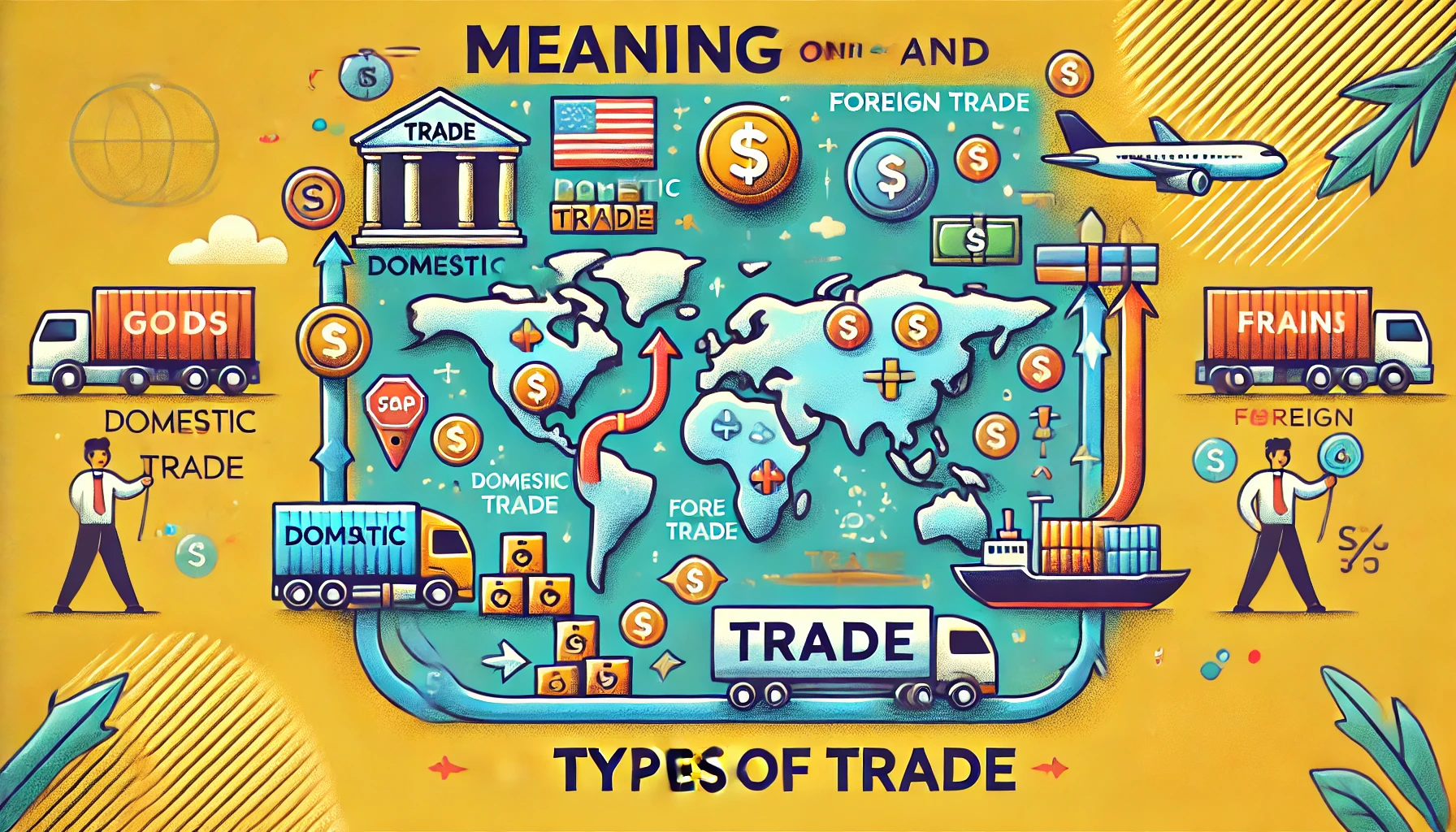Definition of Trade: Trade refers to the exchange of goods, services, or both between two or more parties. It is a fundamental economic activity that allows individuals, businesses, and countries to acquire goods and services that they cannot produce efficiently on their own or that they desire from other producers. Trade can occur on various scales, from local markets to global transactions, and it can involve the exchange of tangible goods like products and raw materials or intangible services like expertise and intellectual property.
Types of Trade
Trade, the exchange of goods and services, can be classified into several types based on various criteria such as geographical scope, method of exchange, and the parties involved. Below are the primary types of trade:
Table of Contents
1. Based on Geographical Scope:
a. Domestic Trade:
- Definition: Trade that occurs within the borders of a single country.
- Types:
- Local Trade: Trade within a specific locality, city, or region.
- Inter-regional Trade: Trade between different regions or states within the same country.
- Examples: A farmer selling produce at a local market, or a manufacturer selling goods to retailers across different states.
b. International Trade:
- Definition: Trade between parties located in different countries. It involves exporting and importing goods and services across national borders.
- Types:
- Export Trade: Selling goods and services produced in one country to another country.
- Import Trade: Buying goods and services from another country to sell or use domestically.
- Entrepot Trade: Importing goods from one country and re-exporting them to another after some processing or repackaging.
- Examples: The United States exporting machinery to Canada, or India importing crude oil from Saudi Arabia.
2. Based on Method of Exchange:
a. Barter Trade:
- Definition: The direct exchange of goods and services without using money as a medium of exchange.
- Characteristics: Goods or services are exchanged directly, and the value is negotiated between the trading parties.
- Examples: A farmer exchanging grain for tools from a blacksmith.
b. Monetary Trade:
- Definition: Trade where goods and services are exchanged for money. This is the most common form of trade in modern economies.
- Characteristics: Involves the use of currency as a medium of exchange, making transactions more convenient and standardized.
- Examples: Purchasing groceries with cash or using a credit card to buy clothing.
3. Based on the Number of Countries Involved:
a. Bilateral Trade:
- Definition: Trade between two countries, often governed by a bilateral trade agreement that outlines terms such as tariffs, quotas, and trade restrictions.
- Characteristics: Focuses on trade relations between two specific countries, with mutual benefits.
- Examples: The trade agreement between the United States and Mexico under the USMCA (United States-Mexico-Canada Agreement).
b. Multilateral Trade:
- Definition: Trade that involves more than two countries. It is often facilitated by international organizations or trade agreements that promote global trade and reduce barriers.
- Characteristics: Involves multiple countries, promoting broader trade relations and economic cooperation.
- Examples: The World Trade Organization (WTO) facilitating global trade negotiations, or the European Union’s single market allowing free trade among member states.
4. Based on the Goods and Services Traded:
a. Visible Trade (Merchandise Trade):
- Definition: Trade involving tangible goods that can be physically seen and measured.
- Characteristics: Includes the import and export of raw materials, manufactured goods, and agricultural products.
- Examples: The export of cars, electronics, and textiles, or the import of oil, metals, and machinery.
b. Invisible Trade:
- Definition: Trade involving intangible services rather than physical goods.
- Characteristics: Includes services such as banking, insurance, tourism, consulting, and intellectual property.
- Examples: A country exporting financial services through its banks, or a firm providing software development services to clients in another country.
5. Based on Trade Direction:
a. Export Trade:
- Definition: The sale of goods and services produced in one country to another country.
- Characteristics: Generates foreign exchange for the exporting country and expands market reach for producers.
- Examples: China exporting electronics to the United States, or Brazil exporting coffee to Europe.
b. Import Trade:
- Definition: The purchase of goods and services from another country for use or resale in the domestic market.
- Characteristics: Allows a country to acquire goods and services not available or cost-effective to produce domestically.
- Examples: Japan importing crude oil, or the United States importing textiles from Bangladesh.
c. Entrepot Trade (Re-export Trade):
- Definition: The import of goods from one country and their re-export to another country after some processing or repackaging.
- Characteristics: The goods are often imported duty-free and re-exported, sometimes after value addition.
- Examples: Singapore importing raw materials, processing them, and re-exporting finished products.
Conclusion
Trade is a multifaceted economic activity that can be categorized in various ways depending on its scope, method, participants, and the nature of goods or services exchanged. Understanding the different types of trade is essential for grasping how economies interact, grow, and benefit from the global exchange of goods and services. Each type of trade plays a critical role in shaping the economic relationships between countries, regions, and businesses.

